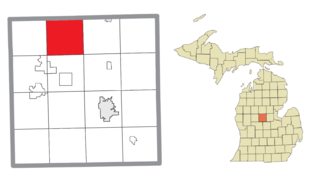
Lake Charter Township is a charter township of Berrien County in the U.S. state of Michigan. The population was 2,972 at the 2010 census.

Dwight Township is a civil township of Huron County in the U.S. state of Michigan. The population was 930 at the 2000 census.

Gilmore Township is a civil township of Isabella County in the U.S. state of Michigan. The population was 1,376 at the 2000 census.

Nottawa Township is a civil township of Isabella County in the U.S. state of Michigan. The population was 2,225 at the 2020 census.

Rolland Township is a civil township of Isabella County in the U.S. state of Michigan. The population was 1,210 at the 2000 census.

Barryton is a village in Mecosta County in the U.S. state of Michigan. The population was 405 at the 2020 census, up from 355 in 2010. The village is located in Fork Township on M-66.
Chippewa Township is a civil township of Mecosta County in the U.S. state of Michigan. As of the 2020 census, the township population was 1,227.
Colfax Township is a civil township of Mecosta County in the U.S. state of Michigan. The population was 1,962 at the 2020 census.
Grant Township is a civil township of Mecosta County in the U.S. state of Michigan. As of the 2020 census, the township population was 702.
Green Charter Township is a charter township of Mecosta County in the U.S. state of Michigan. As of the 2020 census, the township population was 3,219. The township was organized in 1858, before Mecosta County was detached from Newaygo County.
Hinton Township is a civil township of Mecosta County in the U.S. state of Michigan. As of the 2020 census, the township population was 1,054.
Mecosta Township is a civil township of Mecosta County in Michigan. The population was 2,435 in accordance with the 2000 census. The Village of Mecosta, which is also in Mecosta County, is in Morton Township, several miles to the east.

Lakeview is a village in Cato Township in Montcalm County of the U.S. state of Michigan. The population was 1,007 at the 2010 census. The village is within Cato Township.

Pierson is a village in Montcalm County of the U.S. state of Michigan. The population was 172 at the 2010 census. The village is within Pierson Township.
Croton Township is a civil township of Newaygo County in the U.S. state of Michigan. The population was 3,042 at the 2000 census. Known as the "Party Capital" of Mid-Michigan, Croton lies on the banks of the majestic Muskegon River. Nestled between the Croton Dam and Hardy Dam, an artificial lake is created which plays hosts to world-class fishing, boating, and natural scenery. Often, referred to as "Michigan's Secret Paradise" Croton is lauded as a quiet get away, especially during the warm summer months.

Brockway Township is a civil township of St. Clair County in the U.S. state of Michigan. As of the 2010 Census, the township population was 2,022.
Aetna Township is a civil township of Mecosta County in the U.S. state of Michigan. As of the 2020 census, the township population was 2,241.
Austin Township is a civil township of Mecosta County in the U.S. state of Michigan. As of the 2020 census, the township population was 1,715.
Deerfield Township is a civil township of Mecosta County in the U.S. state of Michigan. The population was 1,785 at the 2020 census.
Wheatland Township is a civil township of Mecosta County in the U.S. state of Michigan. The population was 1,474 at the 2000 census.











